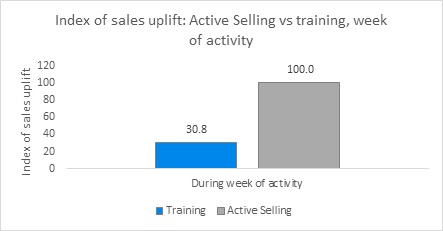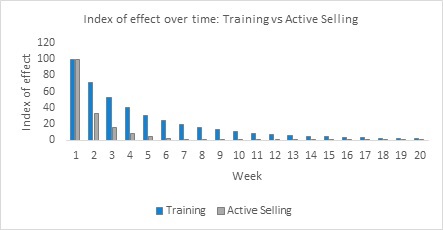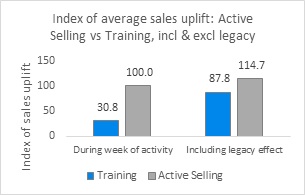Teaching a man to fish: The true value of in-store training Fields Sales Insight from Rhys Jones, Retail Alchemy
Posted by
Like most agencies that specialise in technology, many of our clients invest large sums of money in the training of in-store sales colleagues in the hope that this will lead those colleagues to upsell their products to consumers. After all, the old adage of ‘teaching a man to fish’ vs giving him a fish would seem to ring true.
The trouble is most traditional forms of ROI analysis routinely fail to detect an uplift from such activity thereby creating the view amongst clients and agencies alike that training either does not work or is measured by more intangible measurements like a build-up of brand equity or advocacy amongst in-store colleagues.
Whilst the latter of these views is undoubtedly true, our work with a number of our agency a nd brand partners has indeed shown that training does in fact have a tangible sales benefit, albeit one that uplifts sales in a slightly subtler way than more traditional forms of in-store activity such as active selling or merchandising.
nd brand partners has indeed shown that training does in fact have a tangible sales benefit, albeit one that uplifts sales in a slightly subtler way than more traditional forms of in-store activity such as active selling or merchandising.
To illustrate this, let’s start by examining the impact of in-store training versus that of active selling immediately during or after the activity took place in store. Indeed, this is often the timescale over which most traditional forms of ‘trial versus control’ analysis are conducted:
From this, it’s clear that active selling massively outperforms in-store training by a ratio of 3.2 to 1, which is obviously where our initial assertion around in-store training not working comes from. However, using such a timescale to observe results fundamentally ignores the point of in-store training in the first place: that is, whilst more modest initially than actively selling to a consumer, training should lead to a more sizeable uplift in sales in-store, but at a fraction of the cost of the visit given store staff are essentially ‘free’ advocates for the brand from an agency or brand point of view.
 Indeed, using a much wider timescale in our analysis than is traditionally used, we found exactly that to be the case. By statistically testing a range of ‘legacy effects’ for both training and active selling, we found that, on average the effect of training lasts for around 3.1 times longer than that of active selling:
Indeed, using a much wider timescale in our analysis than is traditionally used, we found exactly that to be the case. By statistically testing a range of ‘legacy effects’ for both training and active selling, we found that, on average the effect of training lasts for around 3.1 times longer than that of active selling:
Factoring this into our uplift calculations, we found that training, therefore, actually generates an uplift that is on a par with active selling albeit over a much wider timescale. However, perhaps more importantly, such an uplift is generated at a fraction of the cost given that the uplift generated by active selling is quite time and resource intensive in that by its very nature it requires agency personnel to be ‘active’ in-store in order to generate the uplift. Training, conversely, simply requires agency personnel to impart their knowledge to store staff; with the bulk of the uplift being created by the essentially ‘free’ resource in-store over a much greater time period. Taking this into account, we found that, in terms of ROI, training actually outperforms active selling by around 31.2% overall:

 It’s clear, therefore, that ‘teaching a man to fish’ is a far more economical use of resources than actually fishing for him when it comes to promoting brands in-store: but the industries definition and measurement of ROI needs to adapt to how activity is designed to work, rather than being a ‘one size fits all’ definition.
It’s clear, therefore, that ‘teaching a man to fish’ is a far more economical use of resources than actually fishing for him when it comes to promoting brands in-store: but the industries definition and measurement of ROI needs to adapt to how activity is designed to work, rather than being a ‘one size fits all’ definition.







